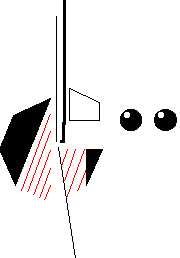

The GRETSS*
pioneers
|
[ home] [French societies] [security] [engines] [1977 - 1983 projects] [1983 - 1993 projects] [Paral'bol 1993 - 1996] [Céphéide 1996] [another sites]
[Hilare] [Pléonasme2] [Jtenpoz] [Faontasme] [Gretss connection] [L'aplubel] [Léviathan]
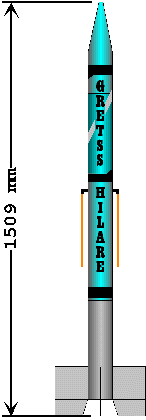
HILARE (1977 - )
In the absence of detailed documentation or the clubs founders, I am unable to describe this rocket in detail. The rocket was to be powered by a chamois & measured 1.50m long with a diameter of 90mm. It had two moustache like antennas for its telemetry system, which still exist covered in dust in the stores of the club. It was never launched, which is a complete mystery to me. Nevertheless, we will pass quickly onto the second project of the club which is much more interesting. |

PLEONASME2 (1978 - 1979)
|
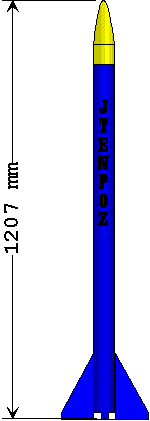
JTENPOZ (1979 with
the MAC and the CAC)
With the aim of being fully involved in the organisation of launch campaigns, GRETSS* helped MAC (from Marseille) & CAC (Club Aérospatial de la Celle Saint Cloud) to build a rocket powered by a bambi motor in less than 24 hours during the August 1979 campaign. The aim of this project was to qualify all the teams involved in the launch of a rocket (PC, weather constraints, tracking stations, telemetry etc). In general this is the first launch of the campaign. Rather than launch an empty tube, the three clubs collaborated to build a real "experimental rocket" which was launched on the 25th August 1979. |
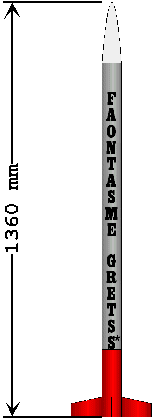
|
It was with this project that things seriously started & GRETSS* gained a reputation for "know how" in experimental rockets. The slogan of Bruno-B at this time was "small is beautiful". So the team decided to use a faon motor with a 63mm diameter & believe me it wasn't obvious how to do anything in such a small diameter. The electronics was comprised of the following :
Mechanical construction:
|
We had wanted to build a light rocket, matched to the faon motor, but in the end it became a flying brick with a weight of 3.7kg. Anyhow, it was a nice piece of work for a small (63mm) diameter & 1.36m length without aerials
A peak altitude of 2250m after 23
seconds of was predicted for this rocket.
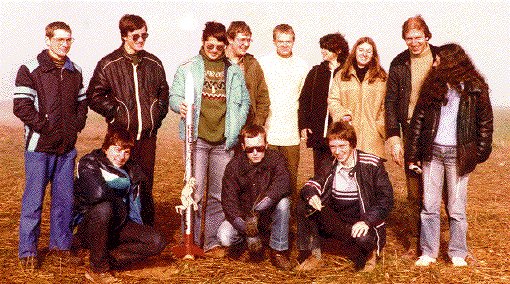
From left to rigth around Faontasme: Jean-Louis Lilienfhein, Etienne Sigel (squat), Tu flippes, Bruno Hébert, ???, L'asocial (squat), Jean-Louis Galani, ???, Bertrand Eiselé (squat),???, Claude ???, ???
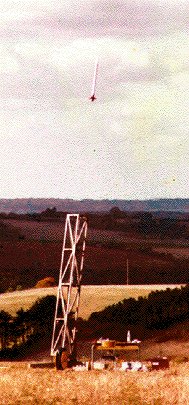
| A launch was attempted on the 31st August 1980 at the military camp at Ruchard. However, due to several problems, above all with the telemetry transmitter, the launch was not made. After a month of analysis & repairs a second attempt was made to launch FAONTASME. on the 19th October, near to Auxerre. Finally, after a number of last minute "glitches" we launched. In an instant the little metal arrow left the launch tower & thundered skywards to be lost from view. A moment of anxiety & then someone caught sight of her near maximum altitude. The parachute opened & she descended slowly to earth in full view of everyone. The telemetry had worked perfectly & two members of the club already had graphs in front of them. After 15 minutes the rocket was recovered. After a short explanation to the public we cracked open the champagne & celebrated a successful conclusion to a years work. |
A years work, & camaraderie, an essential combination.

GRETSS CONNECTION (1980 - 1981)writing in progress Like FAONTASME, GRETSS CONNECTION used a faon motor, but smaller & more compact. |

L'APLUBEL (1980 -
1981)
|

|
Propelled by a bambi motor this rocket measured airspeed using a small propeller mounted on the top of the nose. An opto-electronic sensor measured the propeller rotation rate & transmitted this to the ground using an IRIG telemetry system. The rocket was also know as the "Spanish
Kit". This is because the rocket was finished during
holidays in Spain (Imagine the conceptor with all the
necessary tool, at 1000 Km home on a beach in Spain with
its rocket!). |
[Hilare] [Pléonasme2] [Jtenpoz] [Faontasme] [Gretss connection] [L'aplubel] [Léviathan]
[ home] [French
societies] [security] [engines] [1977
- 1983 projects] [1983 - 1993 projects] [Paral'bol
1993 - 1996] [Céphéide 1996] [another
sites]
http://www.multimania.com/gretss/